- This compilation briefly tells of Chola kings from 850-1279 i.e. 479 years, Naval power, Political organization, Village functioning, Chola bronze & extracts from a Foreword by K M Munshi.
The
Tamil movie Ponniyin Selvan has made many curious about the Cholas.
This
compilation provides information about the Chola dynasty. It is based on volumes
5 and 6 of the History and Culture of the Indian People (HCIP) published by the
Bharatiya Vidya Bhavan. All credits to publisher and authors. These volumes are
my Holy Gita, for Indian history.
I
got to know about the Cholas during a Tamil
Nadu Temple Tour when I visited Kallanai Dam near Trichy and saw temples
built by them.
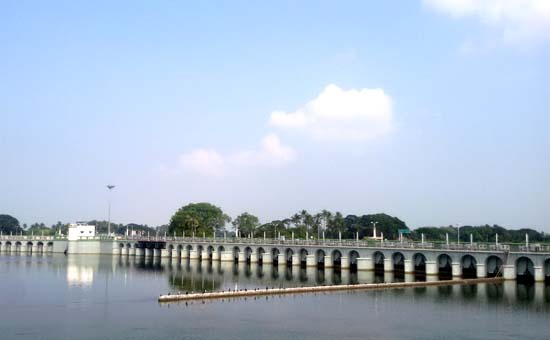 Modern day Kallanai Dam Trichy said to be built by a Chola king.
Modern day Kallanai Dam Trichy said to be built by a Chola king.
“The Kallanai Dam was “built during the 2nd century AD by Karikalan, a king of Chola Dynasty” and “is also one of the oldest irrigation systems in the world that is still in use” (Agoramoorthy and Hsu, 2008). “The purpose of the dam was to divert the waters of the Kaveri across the fertile Thanjavur delta region for irrigation via canals. Since the English arrived in the 18th century, the dam was tampered with and hydraulic structures have been added nearby. It is therefore difficult to extrapolate from the current situation into the past to understand the workings of the Anicut” (Bijker, 2007).” Source
Kulapati K M Munshi wrote about the Cholas in the Foreword to Volume 5 of HCIP, “But the most important of them and brilliant in cultural achievements was the empire of the Cholas of Tanjore (985-1250). Rajaraja Chola (985-1014) set up an efficient administration, ruled well and a great patron of art and literature. He built the Brihadesvara Temple. Under his son Rajendra Chola (1022-1044) the empire reached its zenith.
The
Chola Emperors were the first to recognise the value of naval power. They won a
colonial empire that embraced Ceylon, the Nicobar Islands, the Malaya Peninsula
and Sumatra.
Their
administratrative organization had a strong centralized machinery and an
efficient system of audit. They made the famous anicuts across the Kaveri. Literature blossomed and art flourished
under the Cholas.
During this period, the Hindu kingdoms of Suvarnadvipa formed part of Dvipantara-Bharata, ‘India beyond the Seas’. They had close contacts with India, and South India and Bengal influenced them considerably.” 1
“It is worth noting that the earliest references to the Cholas date as far back as the 3rd century BCE, and were made by the Mauryan emperor Ashoka.
However, very little evidence exists about the early Cholas, apart from the
early Tamil literature of the third Sangam, and the references made about them
in an ancient Graeco-Roman periplus written in the early centuries of the
Common Era. After a long eclipse, the Chola Empire as we know it in all its
glory, emerged sometime in the mid ninth century under King Vijayalaya Chola. Indian Express 3
A. Chronology of the Chola Kings post 850 A.D. and about them
1.
Vijayalaya (850-871, a feudatory of the Pallavas).
2.
Aditya I (871-907).
3.
Parantaka I (907-953).
4.
Confusion followed by Uttama Chola (973-985).
5.
Rajaraja the Great (985-1014)
6.
Rajendra I, Gangaikonda Chola (1012-1044).
7.
Rajadhiraja I (1018-1052) and Rajendra II (1052-1064)
8.
Virarajendra I (1063-1070) and Adirajendra (1068-70).
9.
Kullottunga (1070-1120)
10.
Vikram Chola (1118-1135) and Kulottunga II (1133-1150).
11.
Rajaraja II (1146-1173) and Rajadhiraja II (1163-1179).
12.
Kulottunga III (1178-1216).
13.
Rajaraja III (1216-1246) and Rajendra III (1246-1279).
14.
Kop-perunjinga
1. Vijayalaya (850-871)
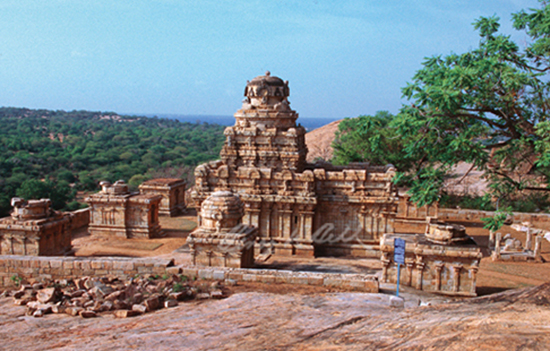 Vijayalaya Choleeshwaram temple renovated by
Vijayalaya Chola.
Vijayalaya Choleeshwaram temple renovated by
Vijayalaya Chola.
Vijayalaya
captured Tanjore from the Mutta-raiyar, feudatories of the Pallavas. After the
conquest he built a temple for Durga there.
Above
and next pic are courtesy and copyright Benoy K Behl.
2. Aditya I (871-907)
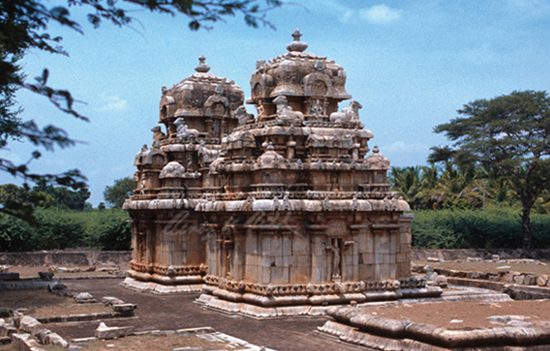 Moovar Kovil Temple Kodambalur was built by Bhooti Vikrama Kesari of the Irukkuvel clan, an ally of and contemporary of Aditya Chola.
Moovar Kovil Temple Kodambalur was built by Bhooti Vikrama Kesari of the Irukkuvel clan, an ally of and contemporary of Aditya Chola.
Aditya
took part in the great battle of Sripurambiyan in which the Pandyas were
defeated. He won various wars and expanded his territory. He married a Pallava
princess. Though the nucleus of the Chola kingdom was created by Vijayalaya,
the real founder of its power was Aditya I, a prince of striking ability,
energy and wisdom. 2 Pg. 154
3. Parantaka I (907-953)
He
led various military campaigns with the help of his allies. By these successful
wars he built up the Chola Empire which attained fame under his successors.
He
conquered Madura. About 915 he defeated the combined forces of Madura and
Ceylon. About 923 he described himself as Maduraiyum
Ilamum Konda or captor of Madura and Ceylon. Through conquests he enlarged his empire which extended from the North Pennar to Cape Comorin and was bounded on the west by Chera and West Ganga kingdoms. Not long after that the Rashrakuta king Krishna III invaded Tondamandalam with the support of the Western Ganga Chief. In this 949 A.D. battle the Cholas were defeated and Parantaka I’s son lost his life.
Parantaka
was devoted to Siva and made many temples. He provided the Nataraja shrine at
Chidambaram with a gold roof.
Also read Map
showing the extent of the Chola Empire
4. Confusion followed by Uttama Chola (973-985)
During
reign of Uttama Chola (953-957) the need for recovering Tondamandalam was not
lost sight of. He is regarded as the author of a single hymn on the Chidambaram
temple. The earliest Chola coin is a gold piece belonging to the reign of
Uttama Chola. 2 Pg. 157 Rajaraja was
made the heir of Uttama.
5. Rajaraja the Great (985-1014)
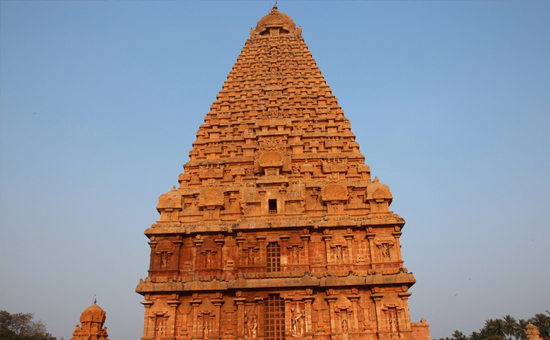 Brihadesvara Temple, Tanjore was completed in 1010.
Brihadesvara Temple, Tanjore was completed in 1010.
The
first great victory was achieved when he destroyed the Chera navy at
Trivandrum. Next he captured Madurai. Then attention was Coorg and he got
select areas into his possession to check the power of the Pandyas and Cheras.
The expedition to Ceylon resulted in the annexation of the northern part of the
island. He ruined Anuradhapura and built there a stone temple, the Siva Devale.
He won and lost against the Western Chalukyas, king Satyasraya confined the Cholas to the South of the Tungabhadra. Marriage of his daughter to the king’s brother paved the way for the union of the Eastern Chalukyas and the Cholas. Rajaraja conquered Kalinga too. Lastly, he conquered the Maldive islands.
His
empire included the whole of South India up to the Tungabhadra, the Maldives
and a part of Ceyon, the Andhradesa was in a feudatory alliance with him.
He
conquered and ensured region was administered properly. He started a land
survey in 1000 A.D., strengthened the imperial administration and encouraged
local self-government. In 1012 he associated his son Rajendra in governance.
He
cooperated in the construction of the Chudamani Vihara, a Buddhist monastery at
Negapatnam, by the Sailendra Emperor and assisted in the construction of Vishnu
temples which enjoyed his and sisters patronage.
6. Rajendra I, Gangaikonda Chola (1012-1044)
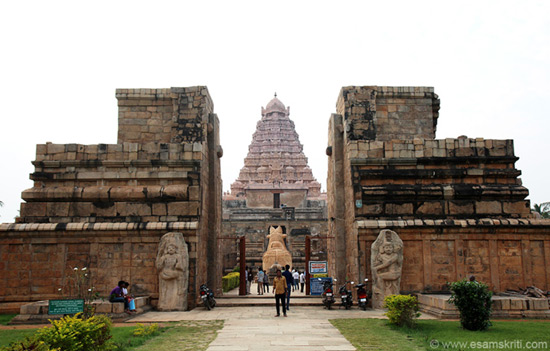 Gangaikondacholapuram Mandir near Trichy.
Gangaikondacholapuram Mandir near Trichy.
The
Tirumalai rock inscription issued in 1024 gives a complete list of his
continental conquests as Yuvaraja. In
1018 Ceylon was completely conquered followed by destruction and looting. In
the same year he deprived the Chera ruler of his crown. Next was expedition to Eastern
India. Crossing the Godavari and passing through Bastar and Orissa, the Chola
army reached Western Bengal and defeated two rulers.
Water
was brought from the Ganga, poured into Cholagangam,
the large irrigation tank excavated near the new capital Gangaikondacholapuram.
Rajendra’s overseas expedition were confined to Sumatra and Malay Peninsula. The last years of Rajendra is when his son Rajashiraja won a victory against the Western Chalukyas. The Cholas offended seriously against the ethics of warfare even in the days of Rajaraja the Great and Rajendra. 1 Pg. 240
Rajendra
acquired various titles during the about 32 years he was active in extending
the Chola Empire. The first title meant he captured the crowns of the Pandya,
Kerala and Ceylonese kings. The second and third indicate his great continental
and overseas achievements. The fourth records the provision at an important
Vaishnava centre for a Vedic College with 340 students learning the Vedas, Vyakarana, Mimamsa and Nyaya under 14 teachers.
7.
Rajadhiraja I (1018-1052) and Rajendra II (1052-1064)
Rajadhiraja
was made joint ruler with his father as early as 1018. Troubles in Ceylon
continued but drastic steps were taken to remove them. In the battle of Koppam
the Chalukya king Somesvara was defeated but Rajadhiraja lost his life.
His
younger brother Rajendra II crowned himself on the battlefield and erected a
pillar of victory in Kolhapur. Inspite of frequently defeating the Chalukyas
the Cholas were unable to permanently annex any part of their territory.
Rajadhiraja performed a horse sacrifice in 1044. A 1048 inscription near Pondicherry mentions a Vedic college with 260 students and 12 teachers that was supported by him. He is referred to as ‘who died on the elephant back.’
Rajendra II marched against Chalukyan king Somesvara in 1062 and defeated him. Rajendra’s daughter Madhurantaki married the Eastern Chalukya prince Rajendra who was later known as Kulottunga I.
8. Virarajendra I (1063-1070) and Adirajendra
(1068-70)
Rajendra
II was succeeded by his younger brother Virarajendra I who invaded Western
Chalukya Empire in response to a challenge from Somvesvara. But the latter did
not turn up. The Chola king proceeded to Vengi, defeated the Western Chalukyas
near Vijayawada and returned to his capital. He sent an expedition to Ceylon
and crushed a rebellion there. He came into conflict with Somesvara II and both
sides claimed victory.
An
inscription of 1067 mentions the provisions for a Vedic college with a hostel
and hospital at Tirumukkudal and medical staff of 2 doctors etc.
Virarajendra
I was succeeded by his son Adhirajendra who ruled with his father from 1068 to
1070 and few months as sole monarch. His unnatural death and accession of
Kulottunga I resulted in the extinction of the Vijayalaya line.
“The Cholas, along with the Pandyas of Madurai and the Cheras were the three great kingdoms of ancient Tamilakam which roughly corresponds to present day Tamil Nadu, Kerala, Puducherry, Lakshadweep and the southern parts of Andhra Pradesh and Karnataka.” 3
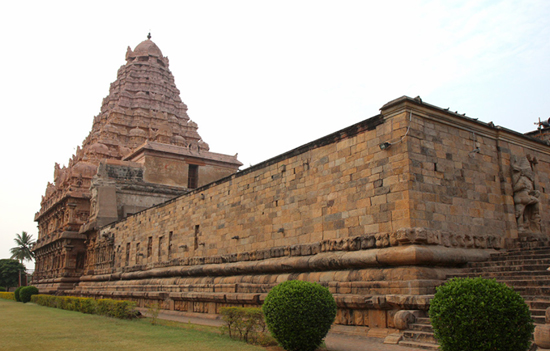 Gangaikondacholpuram Temple.
Gangaikondacholpuram Temple.
9. Kulottunga I (1070-1120)
He
had 75% Chola blood in him because of the alliances between the Cholas and
Chalukyas. There was some anarchy in the Chola Empire before his accession.
Taking advantage the king of Ceylon declared independence. Kulottunga made
peace with him and in 1088 gave his daughter in marriage to a Sinhalese prince.
The troubles of the king during his early years led to the revolt of the Pandya
and Chera countries, but these were reconquered. The rebellion of Venad about
1098 was put down by his famous general, Naralokavira.
He
invaded Kalinga twice in about 1096 and 1110. In the first he quelled the
revolt of Southern Kalinga, a part of Vengi province. The second invasion did
not lead to any annexations. He had friendly relations with the Gahadavalas of
Kanuaj. About 1115 the Chola Empire was nearly as glorious as before except
that a few years later he lost Gangavadi and Vengi provinces (recovered later).
10. Vikrama Chola (1118-1135) and Kulottunga
II (1133-1150)
The year 1128 is memorable for the king’s donations to Nataraja Temple at Chidambaram. A 1121 inscription refers to a Medical School at Tanjore District teaching the Samhita of Charaka and the Samhita of the younger Vagbhata.
Kulottunga
II continued donations to Chidambaram temple but showed religious intolerance
by throwing the image of Govindaraja into the sea. His reign is an epoch in
literary history.
11. Rajaraja II (1146-1173) and Rajadhiraja
II (1163-1179)
During
the reign of Rajaraja II a civil war broke out between the Pandyas. Lankapura,
a Sinhalese general conducted a destructive campaign in Pandya country
necessitating Chola intervention. This protracted warfare continued till about
1177.
Thus,
a century after the accession of Kulottunga I trouble from the feudatories
reached its climax and revealed the central weakness of the Chola empire.
Rajadhiraja II brought the Pandya Civil War to a close.
12. Kulottunga III (1178-1216)
He
gave much attention to Pandya affairs and was largely successful except at the
end of his reign. The king was active in building and improving temples. The
finest work of his reign was the temple at Tribhuvanam (Tanjore District) with
striking Ramayana reliefs.
He
may be regarded as the last great Chola. Many feudatory chieftains rose to
power such as Telegu-Cholas, Banas, Kadavas etc and this impaired the strength
of the central authority. At last, the imperialism of the Pandyas ruined the
Chola empire in the 13th century. 2 Pg. 247
13. Rajaraja III (1216-1246) and Rajendra
III (1246-1279)
Rajaraja
III had to deal with a difficult situation after the rise of the Pandyas, the
Hoysalas, the Kakatiyas etc and his incompetence compounded his difficulties. He
violated a treaty with the Pandyas who defeated him and seized his capital.
Though the Hoysalas saved the Chola power from extinction, they consolidated
their position in the Chola country and attempted to play arbitrators in the
affairs of the Tamils.
Rajendra III was more capable than Rajaraja III. He attempted to increase his power and prestige with the help of the Telegu Cholas. Subsequent to the accession of Maravarman Sundara Pandya II and battles that followed Rajendra’s political position was that of a Pandyan feudatory from 1258 to 1279. Thus, the mighty royal power founded by Rajaraja and Rajendra came to an end.
14. Kop-perunjinga
The
career of this king best shows the decline of the Chola empire. He started as a
loyal feudatory of Rajaraja, but defeated him around 1231. He claims to have
conquered the Cholas, Hoysalas, Pandyas and Kakatiyas. He was devoted to Nataraja
at Chidambaram and built eastern Gopura
of the temple. His character and achievements before and after 1243 exhibit a
remarkable inner unity.
Also read Lessons
from Cholas: Ensuring Order for peace, trade, prosperity Extracts from what Col DPK Pillay (retd) wrote, “Having established a firm hold in India, the Chola looked eastward in the early 11th century; under Rajendra Chola I, they turned their focus to South-East Asia and China. In particular, they looked to the Song empire in China and their booming maritime trade through the Straits of Malacca. Trade in this region was controlled by the Srivijayans; they, with Chinese patronage, dominated commerce through the straits—affecting the local economies of several kingdoms in the Indian Ocean.”
“To break the alliance between the Srivijayans and the Song, the Chola would need to eliminate the former. Working with the Khmer, the Cholas sent two naval expeditions to the region – a smaller one in 1017 as a warning and a larger more devastating one in 1025. It was thus a systematic decimation of the Srivijayans and an altered reality that even the Chinese had to accept.”
B. Political OrganizationCentral Government
The
absolutism of the monarchy was tempered by a ministerial council and an
organised administrative staff, the heads of departments being in close contact
with the king, and often consulted by him. Royal tours contributed to the efficiency
of administration.
There
was brisk commercial intercourse with China, Sumatra, Java, Arabia etc. Some
merchant guilds were big international organizations. Industries were
flourishing esp. jewellery, metal work, weaving and manufacture of salt.
Land was possessed by individuals and communities. Special attention was given to irrigation by government. The proper utilization of the water of Kaveri and other rivers was supplemented by great tanks. The state’s demand of land revenues seems to have been one-third of gross produce at time of Rajaraja I. The proportion was fixed after a land survey.
The
terrible character of Chola warfare was exhibited in the invasions of Pandya-mandalam,
Ceylon and Irratapadi. Enormous spoils of war were obtained by the infliction
of unspeakable miseries on their neighbours. 2 Pg. 251
Naval
achievements of the Cholas reached its zenith during the reign of Rajaraja the
Great and his successor. The Bay of Bengal became a Chola lake. But we cannot
form any idea of the technique of their naval warfare.
Also read Naval
power of the Cholas
“Author Hema Devare in a 2010 article notes that “the Cholas controlled the most extensive shipping from the Coromandel Coast across the Indian Ocean and the Arabian Sea.” She adds: “They employed various sizes of ships. Colandia were large ships used on the voyage up the Ganges, light-coasting boats were for local traffic, and big ocean-going vessels reached Malaya and Sumatra.” 3
“Rajaraja Chola understood that domination of lucrative trade routes was a sure way to distinguish himself and his court from the other fragmented polities of the Tamil country,” writes public historian Anirudh Kanisetti in his book, Lords
of the Deccan: Southern India from the Chalukyas to the Cholas (2022). Rajaraja soon realised that his rivals, the Cheras who were in control of the Malabar coast, were receiving more and more traders from across the seas, especially from the prosperous Fatimid Egypt.” Source Indian Express 3
The
Empire of Rajaraja the Great was divided into eight provinces or mandalams and the latter into valanadus and nadus. It was the village
assemblies that exhibited the greatest and most comprehensive group activity.
The village and town assemblies were primary assemblies while those of nadus were representative institutions.
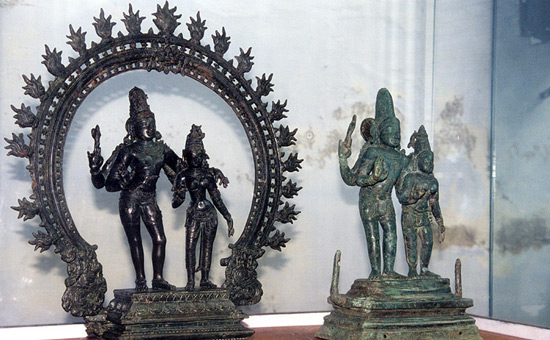 Chola Bronze. Pic by Benoy K Behl.
Chola Bronze. Pic by Benoy K Behl.
Village functioning
The
extent of village autonomy may be from the functioning performed by the
assemblies. The Mahasabha possessed rights over communal lands and controlled
the private lands within its jurisdiction. It worked with the royal officials
in estimating the produce and assessing land revenue. It collected such revenue
and in case of default had the power to sell the land by public auction. Its
approval was required in case of change of the classification of land.
The
Committees looked after village administration with help of paid officials, who
detected crime. The judicial committee, Nyayattar,
settled disputes and pronounced judgements.
The
Mahasabha performed other functions like maintenance of roads and irrigation
works including tanks, supervision of endowments by the dharmavariyam and provision of learning from its own limited
resources.
The
administration of villages was well organised on popular lines, conducive to
the prosperity of its inhabitants and it was such villages exhibiting corporate
activity, which, though in a state of decline, early in the 19th century, formed the ‘little republics’ that exhorted admiration of famous Anglo-Indian administrators.
Also read Cholas
had an efficient and organised monarchic form of governance
C. Chola Bronze
Art historian Benoy K Behl wrote, “The most magnificent image in the bronzes is the Nataraja, Shiva in his cosmic dance. In this dance, he creates and destroys the world. The richness of symbolic meaning in the Nataraja image makes it one of the greatest icons created by man.”
Also read Chola
Bronzes-Darshan of the Divine
“Author Balasubramanyam Venkatraman, in his book Temple
art under the Chola queens, writes that the more significant contributions of Sembiyan Mahadevi were some of the most fascinating bronzes cast at her instance. “She set up a tradition of metal casting that became a matter of pride with her grand-nephew Rajaraja I, in whose time the ateliers of the kingdom brought out innumerable bronzes of unsurpassed quality and grandeur,” he writes. Srinivasan notes that “it is under Sembiyan Mahadevi that the celebrated Nataraja icons in bronze and stone are more prominently displayed in temples.” Then there was Kundavai, the sister of Rajaraja I and his principal queen, Lokamahadevi, who added considerably to Chola art.” Indian Express 3
D. Paintings Brihadesvara Temple
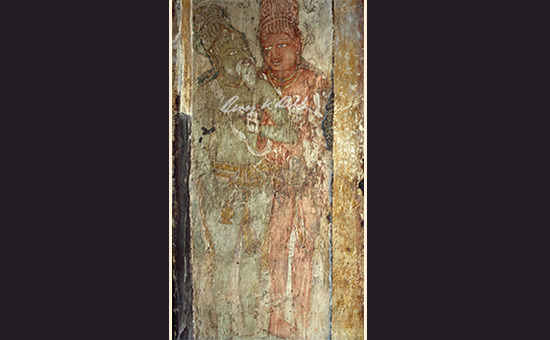 King Rajaraja Chola & Guru Karuvurar, Mural Painting, end-10th century. Pic by Benoy K Behl.
King Rajaraja Chola & Guru Karuvurar, Mural Painting, end-10th century. Pic by Benoy K Behl.
Also read Paintings
Brihadesvara Temple
E. Interesting Points of History about the Cholas
“They were perhaps the only dynasty from Southern India to have moved north, marching into Eastern India, where Rajendra Chola is known to have defeated the Pala king of Pataliputra. They were also the first empire with grand commercial and territorial ambitions outside of the Indian subcontinent. Their singular maritime outreach of expeditions, conquests or trade with respect to Sri Lanka, the Maldives, China, Java/Sumatra and southeast Asia are evoked not only by Chola inscriptions, but also in overseas evidence ranging from inscriptions for Tamil trade guilds (such as from Thailand), to the Song Chinese contacts and Chola-inspired Siva temple in Quanzhou,” says Srinivasan.” 3
Indian Express
Cholas ruled over such a large area over a period of 450 plus years,
made super temples, were a naval power and good administrators. Yet how many
Indians know about them!
This article cannot be republished without written approval of esamskriti.com. All article pictures by Sanjeev Nayyar unless stated and copyright esamskriti.com.
References
1.
The History and Culture of the Indian People
Volume 5.
2.
The History and Culture of the Indian People
Volume 4.
3.
Indian
Express article
Also read
1.
How a Tamil film puts focus on the Cholas
2.
How
successful were the Cholas as Empire builders
3.
Album
Brihadesvara Mandir
4.
Album
Gangaikondacholapuram
5.
Album
Darasuram Temple, Kumbakonam
6.
Paintings
Brihadesvara Temple
7.
About
Cholas book by Neelakanta Shastri
8.
Inscriptions
during the Chola era
9.
The
inspiring battle of Vijayalaya Chola
10. Darshan of the Divine – Chola bronzes
11.
Vijayalaya
Choleeshwar Temple
12. Gautam, P.K. 2013. “The Cholas: Some Enduring Issues of Statecraft, Military Matters and International Relations.” Journal of Defence Studies.